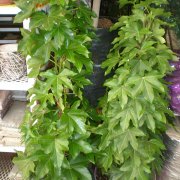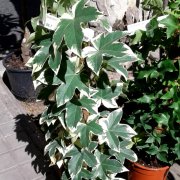Care of the climbing plant Fatshedera or Ivy Tree |
|
This plant is a hybrid between Fatsia japonica and Hedera helix made in 1912 in France by the Lizé brothers. Common name: Ivy Tree. They are evergreen plants with a climbing habit that reach 3 meters (9.84 feet) in height. The leaves are similar to those of the Fatsia but less webbed and wider (20 cm/7.87"). They can produce light green flowers that are not very decorative. Ivy Tree is used as indoor climbing plants or on north-facing terraces and balconies. It's also used to cover walls in shade or semi-shade; it's suitable for hydroculture. Fatshedera needs a very illuminated exposure but without direct sun and a high humidity; sprinkle the leaves from time to time with warm water without lime or place a plate with wet gravel under the pot. It does not resist drafts or be near heating. The soil can be a commercial substrate for humus-rich houseplants. The transplant is done in autumn or spring when the roots appear below the pot. Water abundantly (without flooding and with lime-free water) in spring and summer; reduce watering in autumn and winter water once a week at most. Fertilize weekly in spring and summer with mineral fertilizer. Ivy Tree does not need pruning. To achieve lateral growth, prune the tip of the plant so that it branches laterally. Fatshedera is a plant quite resistant to pests and diseases; sometimes it can be affected by flat mealybugs. Ivy Tree propagates from cuttings (15 cm/5.9") from the tip of the plant that can root both in sand with peat and in water. |
Images of the climbing plant Fatshedera or Ivy Tree |
Find plants
Fatshedera or Ivy Tree | Care and Growing
© 2026 FavThemes


